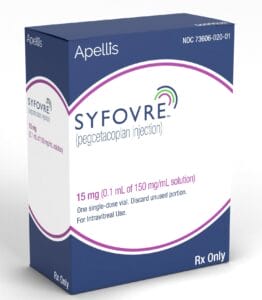June 26, 2023
It’s hard to believe that our first therapeutic treatments for macular degeneration, Macugen/Avastin/Lucentis, were approved and hit the market between 2004 and 2006. While a great treatment for a condition for which we previously had none, it was a treatment for approximately 10% of patients with neovascular AMD (nAMD) out of the entire AMD world. We still had no proven treatment options for the 90% of AMD patients without neovascular disease. It took time, 20 years almost, but we finally have an option for those with geographic AMD. While the new treatments outlined here are a huge step forward in geographic AMD, we certainly still have gaps, especially in patients with dry AMD without geographic atrophy.
First FDA-Approved Treatment for Geographic Atrophy
On Feb 17, 2023, SYFOVRE (pegcetocoplan, Apellis), a C3 complement inhibitor, became the first FDA-approved treatment for geographic atrophy (GA), a leading cause of blindness in the U.S. as well as worldwide. Studies revealed it slowed down the progression of GA, with increasing benefits over time. It also demonstrated a favorable safety profile with few adverse drug reactions over approximately 12,000 injections in 24 months. It has been approved for all patients with GA, with dosing every 25-60 days by intravitreal injection, at a dosage of a single 0.1 ml dose in a single dose vial of 150 mg/mL.1
as worldwide. Studies revealed it slowed down the progression of GA, with increasing benefits over time. It also demonstrated a favorable safety profile with few adverse drug reactions over approximately 12,000 injections in 24 months. It has been approved for all patients with GA, with dosing every 25-60 days by intravitreal injection, at a dosage of a single 0.1 ml dose in a single dose vial of 150 mg/mL.1
SYFOVRE is designed to block complement factor C3, a specific pathway in the complement system that has been implicated in the development as well as progression of GA. Studies implicate that an overactivation of the complement system in the retina is an integral part of GA formation as well as its progression. Therefore, the control of the complement system is critical in limiting the damage to the retina associated with GA.2
Geographic Atrophy: Its Causes and Symptoms
GA is a progressive form of advanced dry AMD characterized by irreversible loss of retinal tissue, specifically the retinal pigment epithelium and choriocapillaris. It is a significant cause of severe vision loss, responsible for more than 20% of all legal blindness associated with age-related macular degeneration. It affects more than five million people worldwide, including approximately one million Americans, with similar prevalence rates to neovascular AMD, both in the U.S. and worldwide.3,4 The prevalence of GA increases with age, roughly quadrupling every 10 years.5 Other risk factors include smoking, alcohol consumption, obesity, cardiovascular disease, and family history.6
Clinical presentation includes lesions that tend to grow over time at varying rates. The lesions typically begin in the extrafoveal region and eventually expand into the macula and cause vision loss as the disease progresses. However, even without foveal involvement, vision can be severely affected due to decreased dark adaptation and parafoveal scotomas that affect the ability to read, drive, or even recognize faces.7
Once thought to be a slowly progressive disease, studies of the natural history of GA are demonstrating that this is not truly the case. In a study done in the U.K., 16% of patients with bilateral GA progressed to blindness in the better seeing eye, with a median time to progression of only 6.2 years. Further, 67% of patients progressed to visual loss, leaving them ineligible to drive with a median time to progression of 1.6 years. Lastly, over 40% of patients with bilateral GA lost greater than 10 letters in the better seeing eye, with a median time to progression of 2.4 years, highlighting the rather quick progression of the disease.8
Phase 3 Studies Determine Efficacy and Safety
The approval of SYFOVRE is based on results of the Phase 3, multi-center, randomized, double-masked OAKS and DERBY studies, evaluating 637 and 621 patients with GA, respectively, receiving injections of the medication either monthly or every other month for 24 months. The goal was to show reduced change in GA lesion growth with treatment vs sham. At 24 months, the DERBY study revealed a 19% reduction in lesion growth in the monthly group and a 16% reduction in every other month versus sham. The OAKS Study demonstrated a 22% reduction in monthly administration and 18% every other month versus sham at 24 months.9 Further, the treatment response was found to be accelerated with longer treatment, with the greatest benefit occurring between 18 and 24 months.10 A new Phase 3 study, the GALE trial, is currently underway to evaluate the long-term incidence and severity of adverse effects, as well as the change in total area of GA.
A key secondary endpoint in the OAKS and DERBY studies was mean change in best-corrected visual acuity (BCVA) at 24 months. No notable difference was observed in BCVA at 24 months in either the monthly or every other month treatment arm. This lack of finding is thought to be due to limitations of the endpoint used and the relatively short time frame studied.9 However, a more recent post hoc subgroup analysis demonstrated that treatment was associated with loss of 5.6 fewer EDTRS letters vs. sham at 24 months in patients with GA lesions located farther away from the foveal center.11
The medication was demonstrated to have a favorable safety profile. The most common adverse reactions (> 5%) were ocular discomfort, neovascular AMD, vitreous floaters, and conjunctival hemorrhage. SYFOVRE was associated with some patients experiencing episodes of transient intraocular inflammation, including vitritis, vitreous cells, iridocyclitis, uveitis, and anterior chamber cells and flare. Acute IOP elevation was found, as may occur with any intravitreal injection, so perfusion of the optic nerve head should be monitored along with IOP and managed should it occur.9
In the Phase 3 clinical trials, SYFOVRE was associated with an increased rate of neovascular or wet AMD vs. control by month 24 (11.9% in the monthly cohort, 6.7% every other month, and 3.1% in the control group). Therefore, patients receiving SYFOVRE should also be monitored for any signs consistent with neovascular AMD and treated accordingly. Further, if anti-vaso endothelial growth factor (anti-VEGF) treatment is required, it should be done separately from SYFOVRE administration. 9
More serious side effects, such as endophthalmitis, retinal detachment, retinal tears or hyphema were reported in less that 1% of treated patients. As with any intravitreal injection, associated endophthalmitis is a rare but serous complication, occurring in approximately one in 3,000 patients over 24 months in the OAKS and DERBY study combined. Proper aesthetic injection technique should be utilized to minimize the risk of endophthalmitis. Further, patients should be instructed to report any symptoms suggestive of endophthalmitis immediately and should be managed appropriately.9
Another Geographic Atrophy Treatment in the Pipeline
A second medication seeking approval for GA, avacincaptad pegol (Iveric Bio), a complement C5 inhibitor, is also in Phase 3 clinical trials. The FDA pivotal trials GATHER 1 and GATHER 2 trials both demonstrated a significant reduction in GA growth rate at 18 months. In the 2 mg. treatment group, a 28.1% reduction in square root area for GA lesion size was demonstrated, with a 30.0% reduction in the 4 mg. treatment group at 18 months. Further, a reduced rate of vision loss was noted in both trials.12 Most adverse events were injection related, with no cases of endophthalmitis in either study at 18 months. The most common adverse effects were noted to be conjunctival hemorrhage (13%), increased IOP (9%), and progression to exudative AMD (7%).12
A recent ad hoc analysis demonstrated that a lower proportion of patients treated with 2 mg. of avacincaptad pegol experienced a 15-letter loss from baseline at 12 months compared to sham. Further, treatment with 2 mg. avacincaptad pegol resulted in 56% risk reduction in persistent vision loss compared to sham at 12 months.13 Iveric hopes to hear whether the drug will be FDA approved by the end of this summer, with a Priority Review with a Prescription Drug User Free Act (PDUFA) goal date of August 19, 2023.
It is an exciting time, both for providers as well as for patients, as there is at least one option and likely to be two options soon to help our patients with GA lead a more independent life, with longer, more functionable vision.
References
1 SYFOVRE prescribing information.
2 Richard AJ, et al. Geographic atrophy: where we are now and where we are going. Curr Opin Ophthalmol. 2021;32 (3): 247-252.
3 Klein R, Meuer SM, Knudtson MD, Klein BE. The epidemiology of progression of pure geographic atrophy: the Beaver Dam Eye Study. Am J Ophthalmol 2008; 146:692–9.
4 Wong WL, Su X, Li X, et al. Global prevalence of age-related macular degeneration and disease burden projection for 2020 and 2040: a systematic review and meta-analysis. Lancet Glob Health. 2014;2:e106ee116.
5 Rudnicka AR, et al. Incidence of Late-Stage Age-Related Macular Degeneration in American Whites: Systematic Review and Meta Analysis. Am J Ophthalmol 2015; 160 (1): 85-93.
6 Kuan et al. Association of Smoking, Alcohol Consumption, Blood Pressure, Body Mass index, and Glycemic Risk Factors with Age-related Macular Degeneration: A Mendelian Randomization Study. JAMA Ophthalmol 2021; 139:1299-306.
7 Sunness JS, Rubin GS, Applegate CA, et al. Visual function abnormalities and prognosis in eyes with age-related geographic atrophy of the macula and good visual acuity. Ophthalmology. 1997;104(10); 1677-91.
8 Chakravarthy et al. Characterizing Disease burden and progression to geographic atrophy secondary to AMD. Ophthalmology 2018 125(6); 842-849.
9 Goldberg R, Wykoff CC, et al. Efficacy of intravitreal pegcetacoplan in patients with geographic atrophy (GA): 12-month results from the phase 3 OAKS and DERBY studies. ARVO: 2022: Denver CO.
10 Apellis Announces 24-Month Results Showing Increase Effects over Time with Pegcetocoplan in Phase 3 DERBY and OAKS Study in Geographic Atrophy (GA). August 24, 2022.
11 Chiang et al. Assessment of geographic atrophy progression in the phase 3 OAKS and DERBY trials. Oral presentation at ARVO Annual Meeting; April 2023; New Orleans, LA.
12 Patel SS, et al. Avacinaptad Pegol for Geographic atrophy secondary to age-related macular degeneration: 18-month Findings from the GATHERT 1 trial. Eye (Lond) 2023. doi: 10.1038/s41433-023-02497. accessed online ahead of print.
13 Khanani A, et al. C5 Inhibition Clinical Trial Data and its Potential Implications in the Real World. Retina World Congress, May 2023: San Diego, CA.





